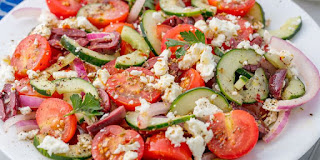What is Salad?
A salad is a dish consisting of a mixture of small pieces of food, usually vegetables. However, different varieties of salad may contain virtually any type of ready-to-eat food. Salads are typically served at room temperature or chilled, with notable exceptions such as south German potato salad which is served warm.
We have over 50 different kinds of salads from all over the worlds and more recipes for salads are emerging everyday. Salads are broadly classified into two categories – simple and mixed salads.
Simple Salads – Theses salads are known as simple salads as they are prepared by using one type of ingredient. Dressing plays a vital role in these types of salads. E.g tomato salads with french dressing
Mixed salads- Unlike simple salads, they are made by combination of more than one type of ingredient. These are also dressed with an apt dressing. Dressing helps in binding the ingredients together. Coleslaw salad with mayonnaise is this type of salad.
What kinds of salads can we prepare?
1. Vegetable salads: It refers to all those salads in which only vegetable ingredients are used. It is served with a suitable dressing. A simple vegetable salad can be made by arranging string beans, corn, beets and asparagus on lettuce. It is often served with Russian dressing.
2 Fruit salads – These salads are made of fruits only. They may contain one or different types of seasonal fruits. Fruits are chopped and then they are usually tossed in a syrup or juice. It acts as a superb dessert which takes very less time to prepare. Fruit salads which are mixed with sugar and alcohol are also known as fruit cocktail.
3. Warm Salads – This salad contain a warm or cooked item as one of its ingredient. For example a salad containing cooked meat will be known as a warm salad. The presence of warm ingredients makes these salads desirable during winters. Warm potato salad etc4. Classical salads – It covers all those salads which have been around since a long time. They also cover many ethnic or cultural salads as they tend to be famous in counter other than the ones in which they originated. These salads are popular for their classic styles of preparation. Thai beef salad is a classical salad.
4. Composed Salads – The ingredients of the composed salad are not mixed and tossed. However, it is the arrangement of ingredients which plays a vital role in this type of salad. After a suitable arrangement of the ingredients, the dressing is poured over it or is served separately. Eg Cobb salads
Health benefits of eating salads
Eating salad almost every day may be one of the most healthy eating habits you can adopt -- and one of the simplest, experts say. Eating salads is a super-convenient way to work in a couple of servings of vegetables and/or fruit for you and the whole family.
If you frequently eat green salads, you'll likely have higher blood levels of a host of powerful antioxidants (vitamin C and E, folic acid, lycopene, and alpha- and beta-carotene,) especially if your salad includes some raw vegetables. Antioxidants are substances that help protect the body from damage caused by harmful molecules called free radicals.
For years, researchers have noted a link between eating lots of fruits and vegetables and lower risks of many diseases, particularly cancer. A recent study from the National Cancer Institute suggests that people whose diets are rich in fruits and vegetables may have a lower risk of developing cancers of the head and neck -- even those who smoke and drink heavily. Foods found to be particularly protective include beans and peas, string beans, peppers, tomatoes, carrots, apples, nectarines, peaches, plums, pears, and strawberries.
If losing weight is your goal, you may want to start your meals with a green salad. Studies have shown that eating a low-calorie first course, like a green salad of 150 calories or less, enhances satiety (feelings of fullness) and reduces the total number of calories eaten during the meal.
So that why we all love salads...






Comments
Post a Comment